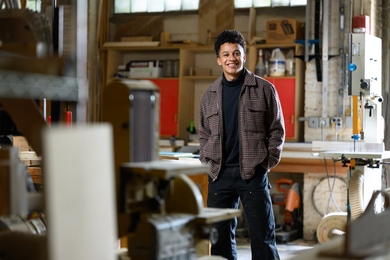For close to 200 MIT employees, "mens et manus," or mind and hand, is more than the Institute's motto-it aptly describes their profession.
These people are the technicians and machinists who collaborate with professors, staff, and students to build the myriad tools, machines, and instruments critical to Institute research.
Specifically, technicians and machinists work with their hands and often computers to turn scientists' ideas into everything from circuit boards to instrument packages for satellites.
The process is highly interactive. "When I'm building a specific device, I work back and forth with the scientist or student involved," said David Breslau, a project technician (mechanical) at the Center for Space Research (CSR).
And that kind of communication "is a tremendous asset," said George W. Clark, Breene M. Kerr Professor of Physics. Professor Clark, who has worked with Mr. Breslau and other technicians on a variety of projects, explained that "it's much more difficult to interact with an outside shop." As a result, outside projects tend to be "very inefficient and expensive."
One recent project Mr. Breslau found particularly interesting was creating a system to study the human vestibular system (which coordinates our sense of balance) and its interaction with ocular nerves.
The researchers involved-Dan Merfeld, a research scientist at the CSR; Keoki Jackson, a graduate student in aeronautics and astronautics, and David Balkwill (MIT SM '92) of Massachusetts Eye and Ear Infirmary-wanted to mount a video camera near a subject's face so that the camera could record any eye movements that occurred during an experiment. The initial design to do this, however, "involved a complicated linkage system that attached the camera mount to both the chair the subject was sitting in and the subject's head," Mr. Breslau said. "It was cumbersome and potentially dangerous."
To build a better system, the scientists asked Mr. Breslau for suggestions. And by asking questions and making initial designs on a Computer Aided Drafting (CAD) system, Mr. Breslau was able to quickly design and machine a set of parts to do the job.
In the successful system, the camera is attached to a modified scuba mask with a biteboard (a dental appliance molded to match the subject's teeth) for stabilization. It has already been used in preflight vestibular studies that will complement similar studies in space aboard the Spacelab Life Sciences 2 shuttle mission, which is slated to be launched this fall, and will be used again in postflight studies.
Anthony J. Caloggero, a project technician (electro-mechanical) at the Lab for Electromagnetic and Electronic Systems, has been at MIT for 25 years. He, too, emphasizes the collaborative nature of his work.
For example, over the last year or so Mr. Caloggero has been working with John G. King, Francis Friedman Professor of Physics, to revive Corridor Lab, a set of self-contained demonstrations along MIT's hallways that illustrate a variety of scientific and engineering principles.
Corridor Lab was actually started some years ago, Mr. Caloggero said, but the exhibits fell into disrepair. Now new demonstrations are being developed by Professor King, Mr. Caloggero, other MIT staff and students in Professor King's freshman seminar. (The initiative is sponsored through the Edgerton Center, which was instituted in 1992 "to provide the kinds of hands-on experiences that incoming students often lack today," according to J. Kim Vandiver, director of the Center and professor of ocean engineering.)
A typical Corridor Lab demonstration, Mr. Caloggero said, might begin as a rough sketch. From there, Mr. Caloggero would build a working model, then Professor King and he "would sit and play with it, and think about ways to make it better."
During this year's IAP the Corridor Lab team installed the first demonstration, which allows users to measure their electrical capacitance, in the science library. Other demonstrations in the works include "a mechanical hand that will reach out and measure the force of your handshake," Mr. Caloggero said, and a machine that will "pull apart a paper clip, to give you an idea of how much force it takes to break it, and how it breaks."
For both Mr. Caloggero and Mr. Breslau, the constant flow of new projects and challenges is exhilarating. "It's almost like I've gotten a free education," Mr. Breslau said.
Perhaps that's part of why many technicians at MIT "have been here for over 20 years," Mr. Breslau said. "Once people come in here, they enjoy it too much to leave."
A New User Group
To enhance the effectiveness of MIT's technicians, machinists, and others who build the equipment for experiments, David Breslau is currently organizing the Ad-Hoc Committee of MIT Manufacturing Staff.
The committee, he said, will serve two primary purposes. First, via the connections made in such a group, technicians could teach each other different skills. "There are many mechanical and electronic skills that I'd love to learn," Mr. Breslau said. "I think it would be much more useful to learn these from someone in the MIT community as opposed to [an instructor] who teaches a generic version. An MIT person could potentially teach you in a more direct way."
Second, the committee could connect members with staff, students and others who need to have something made.
For more information, call Mr. Breslau at x3-7216.
A version of this article appeared in the July 14, 1993 issue of MIT Tech Talk (Volume 38, Number 1).





